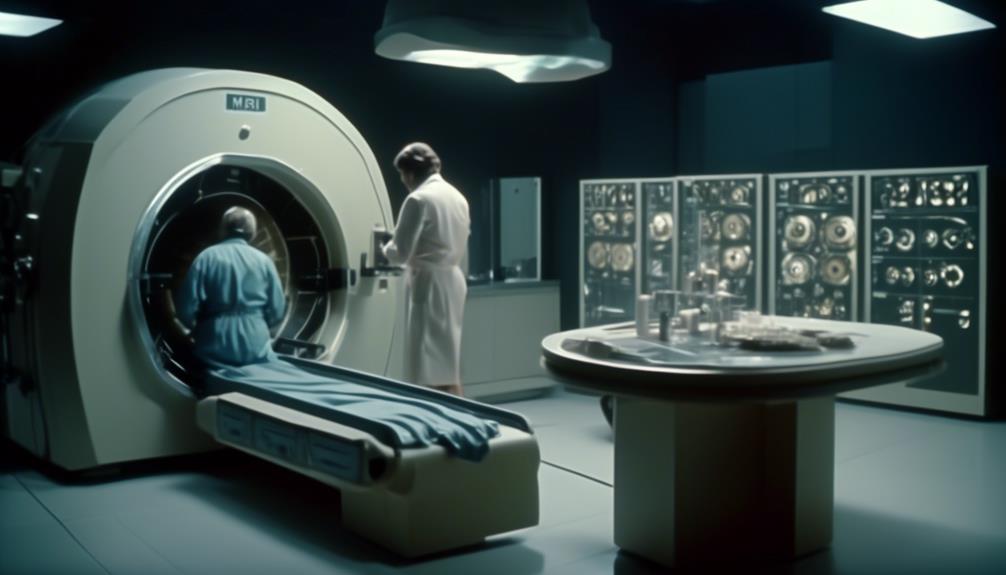Development of MRI Imaging (1971) – Damadian: Recap and Summary: MRI Technology Introduced for Imaging

Dr. Raymond Damadian pioneered the development of Magnetic Resonance Imaging (MRI) technology. This revolutionary technology has completely transformed medical imaging, allowing us to see inside the human body in ways that were previously thought to be impossible.
MRI uses powerful magnets and radio waves to create detailed images of the body's internal structures. By providing a non-invasive and highly accurate method of imaging, MRI has become an essential tool in diagnosing and monitoring a wide range of medical conditions.
Dr. Damadian's groundbreaking work in the field of MRI has had a profound impact on healthcare. His dedication and innovation have paved the way for countless medical advancements and have improved the lives of millions of people around the world.
Key Takeaways
- Dr. Raymond Damadian pioneered the development of MRI technology.
- MRI uses powerful magnets and radio waves to create detailed images of the body's internal structures.
- NMR revolutionized imaging by providing a non-invasive method to visualize the internal structures of the human body.
- NMR technology has numerous applications in medicine, allowing for diagnosis and monitoring of diseases and conditions.
The Discovery of Nuclear Magnetic Resonance (NMR)
The discovery of nuclear magnetic resonance (NMR) revolutionized the field of imaging by providing a non-invasive method to visualize the internal structures of the human body. NMR technology has found numerous applications in medicine, allowing doctors to diagnose and monitor various diseases and conditions.
One of the key advancements in NMR technology is the development of magnetic resonance imaging (MRI), which uses strong magnetic fields and radio waves to generate detailed images of the body's organs and tissues. MRI has become an indispensable tool in modern medicine, enabling the detection of abnormalities such as tumors, infections, and injuries. By providing high-resolution images with excellent soft tissue contrast, MRI allows for accurate diagnosis and treatment planning.
Furthermore, advancements in NMR technology have led to the development of specialized MRI techniques, such as functional MRI (fMRI) and diffusion-weighted imaging (DWI), which provide valuable information about brain function and tissue microarchitecture, respectively.
The versatility of NMR technology extends beyond medical applications. It's also used in chemistry, biology, and materials science to study the structure, dynamics, and interactions of molecules.
Early Experiments With NMR Imaging
You can now explore the early experiments conducted with NMR imaging.
These experiments were crucial in the development of MRI imaging as we know it today.
They provided valuable insights into the discovery and origins of NMR, as well as the initial imaging techniques used.
Furthermore, advancements in NMR technology during this period laid the foundation for the future growth and application of MRI imaging.
NMR Discovery and Origins
During the early experiments with NMR imaging, researchers explored the discovery and origins of this groundbreaking technology. Nuclear Magnetic Resonance (NMR) was initially developed for analyzing the chemical structure of compounds. However, in the 1970s, scientists realized that NMR could potentially be used to create images of the human body. This realization led to the birth of MRI, Magnetic Resonance Imaging. The origins of NMR imaging can be traced back to the work of Paul Lauterbur and Peter Mansfield, who independently developed techniques for spatially resolved NMR. Lauterbur's imaging technique, called zeugmatography, and Mansfield's development of the gradient magnetic field paved the way for the modern MRI technology we use today. These advancements in NMR technology opened up a world of possibilities for medical diagnostics, allowing for non-invasive imaging of the human body and revolutionizing the field of radiology.
Table:
| NMR Applications | NMR Technology Advancements |
|---|---|
| Chemical analysis | Spatially resolved NMR |
| Gradient magnetic field | |
| Zeugmatography | |
| Non-invasive imaging |
Initial Imaging Experiments
Researchers conducted initial imaging experiments using NMR imaging to explore its potential for creating images of the human body. These early experiments paved the way for the development of magnetic resonance imaging (MRI) as a powerful imaging technique.
By applying radio frequency pulses and magnetic fields, researchers were able to manipulate the nuclear spins of atoms in the body and detect the resulting signals. These signals were then used to generate detailed images of the internal structures and organs.
These initial imaging experiments marked a significant milestone in the field of medical imaging, leading to further research advancements and the refinement of MRI technology. Today, MRI is widely used in clinical practice for diagnosing various conditions and guiding treatment decisions, showcasing the incredible progress made in imaging techniques.
Advancements in NMR
Advancing the field of medical imaging, early experiments with NMR imaging showcased the potential of manipulating nuclear spins to generate detailed images of internal structures and organs. These initial advancements in technology laid the foundation for the development of magnetic resonance imaging (MRI), which has had a significant impact on healthcare.
By utilizing the principles of NMR, MRI technology allows for non-invasive visualization of the human body, providing valuable diagnostic information without the need for invasive procedures. The ability to obtain high-resolution images of tissues and organs has revolutionized medical imaging, enabling early detection and accurate diagnosis of various conditions such as tumors, cardiovascular diseases, and neurological disorders.
The continuous advancements in NMR imaging and the subsequent evolution of MRI technology have greatly improved patient outcomes and have become an invaluable tool in modern healthcare.
Dr. Raymond Damadian's Groundbreaking Research
Dr. Raymond Damadian's groundbreaking research revolutionized the field of MRI imaging, paving the way for significant advancements in medical diagnostics. His contributions to MRI technology advancements were instrumental in the development of this non-invasive imaging technique.
Damadian's research focused on the use of nuclear magnetic resonance (NMR) to image the human body. He discovered that different types of tissues had unique NMR signals, which could be used to create detailed images of the internal structures. This breakthrough led to the development of the first MRI scanner, which utilized magnetic fields and radio waves to produce high-resolution images of the body.
Damadian's research not only enabled the diagnosis of various diseases and conditions but also made it possible to monitor the effectiveness of treatments. His pioneering work laid the foundation for further advancements in MRI technology, including the development of more powerful magnets, faster imaging techniques, and the ability to study physiological processes in real-time.
Today, MRI imaging is a vital tool in modern medicine, providing invaluable information for accurate diagnoses and treatment planning. Damadian's research has had a lasting impact on the field of medical imaging, improving patient outcomes and transforming the way we understand and diagnose diseases.
The First MRI Machine: Indomitable
You are about to embark on a discussion about the first MRI machine, a revolutionary imaging technique that marked a groundbreaking medical breakthrough.
This indomitable machine paved the way for unstoppable advancements in MRI technology, transforming the field of medical imaging.
Through its innovative design and application, the first MRI machine set the stage for a new era in diagnostic imaging.
Revolutionary Imaging Technique
The indomitable first MRI machine revolutionized the field of medical imaging with its groundbreaking technology and unparalleled ability to capture detailed images of the human body. This revolutionary imaging technique has opened up new avenues for non-invasive diagnosis and monitoring of various diseases and conditions.
One of the key advantages of MRI is its ability to provide high-resolution images of soft tissues, such as the brain, spinal cord, and joints, which were previously difficult to visualize using other imaging modalities. The MRI machine achieves this by utilizing a powerful magnetic field and radiofrequency pulses to generate detailed images based on the different magnetic properties of different tissues.
To emphasize the significance of this breakthrough, consider the following table:
| Advantages of MRI |
|---|
| High-resolution imaging of soft tissues |
| Non-invasive and does not involve ionizing radiation |
| Can provide functional and structural information |
Despite its many advantages, the first MRI machine also had potential limitations. For instance, it was relatively slow and cumbersome, limiting its widespread use. However, with advancements in technology, future enhancements have allowed for faster scanning times, improved image quality, and increased patient comfort.
Groundbreaking Medical Breakthrough
The invention of the first MRI machine marked a groundbreaking milestone in the field of medical imaging, forever changing the way we visualize and understand the human body. With its ability to produce detailed images of soft tissues and organs, MRI technology has revolutionized diagnostic medicine.
The impact on patient care has been immense, as MRI scans provide physicians with crucial information for accurate diagnosis and treatment planning. Additionally, the non-invasive nature of MRI eliminates the need for exploratory surgeries or potentially harmful radiation exposure.
As MRI technology continues to advance, its potential future applications are vast. Researchers are exploring its use in areas such as functional imaging, which allows for the visualization of brain activity, and targeted drug delivery, where MRI-guided techniques can precisely deliver medications to specific areas of the body.
The groundbreaking nature of the first MRI machine has paved the way for countless medical advancements, ultimately improving patient outcomes and quality of life.
Unstoppable Advancements in MRI
With the groundbreaking invention of the first MRI machine, the field of medical imaging embarked on an unstoppable journey of advancements, making the indomitable nature of MRI technology evident.
This revolutionary imaging technique has opened up a world of unlimited possibilities in the realm of medical diagnosis and research. MRI technology continues to evolve at an astonishing pace, constantly pushing the boundaries of what's possible. New techniques and applications are being developed, allowing for more precise and detailed imaging of the human body.
The development of higher field strength magnets has significantly improved the quality and resolution of MRI images, enabling medical professionals to detect and diagnose conditions with greater accuracy. Additionally, advancements in software and image processing techniques have enhanced the speed and efficiency of MRI scans, reducing patient discomfort and improving overall workflow.
The unstoppable advancements in MRI technology are revolutionizing the field of medical imaging, promising a future filled with even greater innovation and discovery.
Clinical Applications and Advancements in MRI Technology
Clinical applications and advancements in MRI technology have revolutionized the field of medical imaging, providing physicians with highly detailed and accurate images for diagnosis and treatment planning.
The clinical applications of MRI have expanded significantly since its introduction in the 1970s. MRI is commonly used to image various parts of the body, including the brain, spine, joints, and abdomen. It has become an essential tool for diagnosing a wide range of conditions, such as brain tumors, spinal cord injuries, joint disorders, and abdominal diseases.
New techniques in MRI have further enhanced its capabilities. For example, functional MRI (fMRI) allows for the visualization of brain activity by measuring changes in blood flow and oxygenation. This technique has been instrumental in mapping brain functions and understanding neurological disorders.
Diffusion-weighted imaging (DWI) is another technique that measures the movement of water molecules within tissues, providing valuable information about the integrity of white matter tracts in the brain and the presence of acute stroke.
Advancements in MRI technology have also led to the development of specialized MRI scanners, such as cardiac MRI and breast MRI. These scanners are tailored to specific clinical applications, enabling physicians to obtain highly detailed images of the heart and breast, respectively.
Magnetic Resonance Imaging Goes Mainstream
Magnetic Resonance Imaging (MRI) has become widely adopted in mainstream medicine, revolutionizing medical imaging practices and providing clinicians with invaluable diagnostic information. This non-invasive imaging technique utilizes strong magnetic fields and radio waves to produce detailed images of the body's internal structures.
The benefits of MRI technology advancements are numerous and include:
- Improved Image Quality: The latest MRI machines offer higher resolution and faster imaging times, resulting in clearer and more accurate images. This allows healthcare professionals to detect and diagnose conditions with greater precision.
- Expanded Applications: MRI can now be used to visualize a wide range of anatomical structures and pathological conditions. From the brain and spine to joints and organs, MRI provides comprehensive information for diagnosing and monitoring various diseases.
- Advanced Functional Imaging Techniques: In addition to anatomical imaging, MRI has evolved to include functional imaging techniques such as diffusion-weighted imaging and perfusion imaging. These techniques provide insights into tissue characteristics, blood flow, and cellular activity, enabling early detection of abnormalities.
With its numerous benefits and ongoing technological advancements, MRI has firmly established itself as a cornerstone of modern medical imaging. As the field continues to evolve, we can expect further improvements in image quality, faster scanning times, and the development of new applications, ultimately enhancing patient care and treatment outcomes.
MRI Imaging: A Game-Changer in Medicine
MRI imaging has revolutionized the field of medicine, providing clinicians with invaluable diagnostic information and improving patient care. This game-changing technology has been a significant medical innovation, transforming the way we diagnose and treat various conditions.
The introduction of MRI imaging has allowed for non-invasive visualization of the internal structures of the human body. Unlike other imaging modalities, such as X-rays or CT scans, MRI uses a powerful magnetic field and radio waves to generate detailed images of the body's organs, tissues, and structures. This technology has proven to be particularly useful in diagnosing and monitoring diseases and conditions of the brain, spine, joints, and soft tissues.
The ability to obtain high-resolution images with excellent contrast has greatly enhanced the accuracy of diagnoses. MRI imaging has become an essential tool in identifying and characterizing tumors, assessing the extent of injuries, detecting abnormalities in the brain and spinal cord, and evaluating the effectiveness of treatment.
Moreover, MRI imaging has also played a vital role in guiding surgical procedures. Surgeons can use real-time MRI imaging to navigate and target specific areas during complex surgeries, minimizing the risk to the patient and improving surgical outcomes.
Future Developments and Potential Applications of MRI Technology
With ongoing advancements in medical imaging technology, the future of MRI holds promise for further developments and expanded applications. As researchers continue to push the boundaries of this technology, several potential applications and technological advancements are being explored:
- Functional MRI (fMRI): One area of future development lies in the refinement of fMRI techniques. By mapping brain activity, fMRI can provide valuable insights into how different regions of the brain are interconnected and functionally related. Advancements in fMRI technology could lead to improved diagnosis and treatment of neurological disorders, such as Alzheimer's disease and epilepsy.
- MRI-Guided Interventions: Another potential application is the integration of MRI with minimally invasive procedures. By combining real-time imaging with precise instrument guidance, MRI-guided interventions could revolutionize the field of surgery. This technology has the potential to improve the accuracy and safety of procedures, reduce patient discomfort, and enhance surgical outcomes.
- Molecular Imaging: Technological advancements in MRI may also enable the development of molecular imaging techniques. By attaching specific molecular probes to MRI contrast agents, researchers can visualize and monitor cellular processes at the molecular level. This could have significant implications in areas such as cancer detection, drug delivery, and personalized medicine.
As MRI technology continues to evolve, these future applications and technological advancements hold great potential for improving patient care and expanding the capabilities of medical imaging.
Frequently Asked Questions
How Does MRI Technology Work at a Molecular Level?
At a molecular level, MRI technology works by utilizing the principles of magnetic resonance. It detects and measures the signals emitted by hydrogen atoms in the body, providing detailed images that help diagnose medical conditions.
What Are the Potential Risks and Side Effects of Undergoing an MRI Scan?
When you undergo an MRI scan, there are potential risks and side effects to consider. These can include allergic reactions to contrast agents, claustrophobia, dizziness, and temporary hearing loss.
How Has MRI Technology Evolved and Improved Since Its Introduction in 1971?
Since its introduction in 1971, MRI technology has evolved and improved significantly. Through advancements in hardware, software, and imaging techniques, MRI has become faster, more accurate, and capable of producing higher resolution images, enhancing diagnosis and treatment options.
Are There Any Limitations or Barriers to Widespread Adoption of MRI Technology?
There are limitations and barriers to widespread adoption of MRI technology. Some limitations include cost, availability, and patient contraindications. Barriers include lack of training, infrastructure, and cultural acceptance.
What Are Some Alternative Imaging Techniques That Can Be Used in Conjunction With or Instead of Mri?
You may consider ultrasound imaging or a CT scan as alternative imaging techniques to complement or substitute for MRI. These methods offer different perspectives and may provide valuable information for diagnostic purposes.









